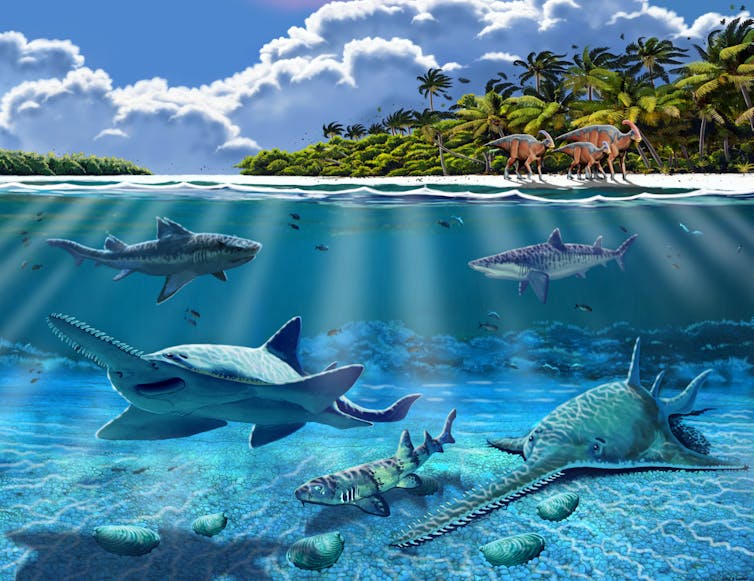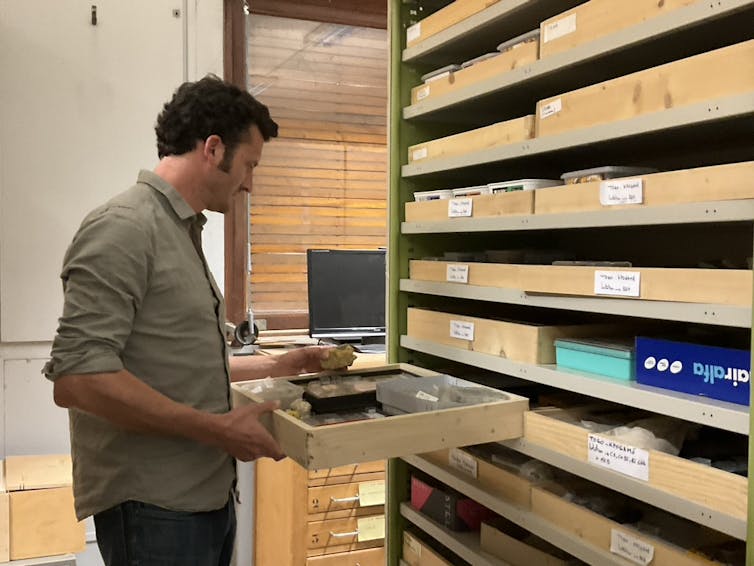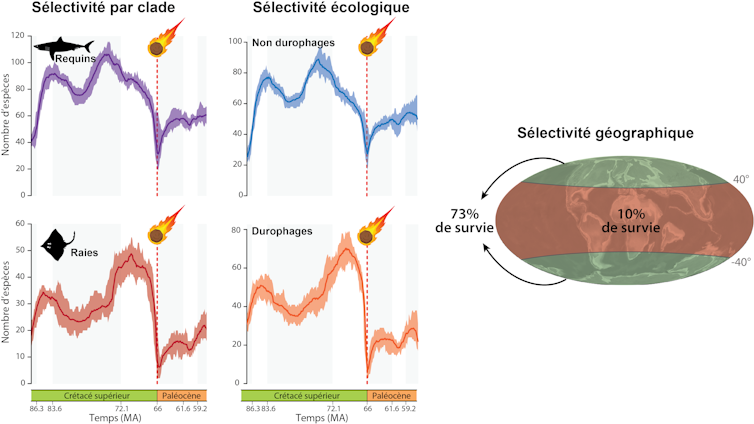Rays and sharks hit hard by the last mass extinction 66 million years ago
The last mass extinction in the evolution of life took place 66 million years ago (Ma), marking the Cretaceous/Paleogene boundary. While this biological crisis is known to have caused dramatic global extinctions and wiped out major vertebrate groups such as the dinosaurs, the consequences of this extinction on marine biodiversity are still the subject of intense debate. We have just published a study in the journal Science on the impact of this crisis on the diversity of elasmobranchs (sharks and rays), a major group of marine vertebrates to have survived this mass extinction. Our work shows that this crisis was brutal and that it affected elasmobranchs in a heterogeneous way, both in terms of the groups affected and the geographical distribution of species.
Guillaume Guinot, University of Montpellier

Previous estimates suggest that this crisis eradicated over 40% of genera and 55-76% of species. However, a growing body of evidence suggests that the scale of this event varied between groups, ecologies (e.g. diets, lifestyles), and geographic areas.
However, global estimates of the loss of diversity during this period have mainly been extrapolated from data for marine invertebrate groups, which alone cannot reflect the complexity of extinction modalities during this crisis. Marine vertebrates, because of their higher position in the food chain, could therefore provide new information on this extinction and on the post-extinction recovery of faunas. But only if these groups survived!
Among these marine vertebrates, elasmobranchs are an emblematic group of predators that were already an important component of marine ecosystems in the Cretaceous, and had developed a wide range of ecologies. Belonging to the cartilaginous fish class (chondrichthyans), these organisms have skeletons that rarely fossilize. However, they are represented by an abundant fossil record, mostly composed of teeth that are lost and replaced throughout their lives, and whose morphology enables species identification. The quality of their fossil record, their presence before and after the extinction event and their position at the top of the food chain make sharks and rays an excellent case study for analyzing the impact of this crisis on marine vertebrates.
Using fossil data, our aim was to quantify precisely the extent of the extinction, the profile of victims and survivors, and the consequences of this crisis on the evolution of shark and ray faunas after the extinction.
Over ten years of data compilation
We first compiled all the fossil record data for all elasmobranch species over a time span of around 40 million years (from -93.9 to -56 Ma), including the extinction event. This long-term project, spanning more than a decade, not only inventoried the shark and ray species present over the Upper Cretaceous-Paleocene interval, but also their occurrences: all the times when fossils have been found for each of these species. This information is disparately available in several hundred scientific works published from the 19th century to the present day, and had to be compiled.
A species can therefore have several occurrences, and each occurrence corresponds to a distinct age and geographical coordinates. We were able to inventory over 3,200 occurrences for 675 fossil species, but we had to verify the identifications and geological ages attributed to each of these occurrences in the scientific literature. Indeed, species classification (taxonomy) is a constantly evolving discipline, and it was first necessary to update the classification of each species and sometimes correct erroneous identifications. In addition, the ages of geological formations that have yielded fossils can also be re-evaluated by new studies, and this information has had to be updated. This tedious but crucial work of expertise forms the basis of the analyses we carried out for this study.

Once the data had been compiled, we used statistical models to estimate the ages of appearance and extinction for each of the 675 species. This heavy analytical work is essential, as the fossil record includes a number of preservation and sampling biases. The spatial and temporal heterogeneity of the fossil record must therefore be taken into account before attempting to estimate the lifespan of fossil species. These models, in which Fabien Condamine (co-author of the study) is also a specialist, are then used to estimate speciation and extinction rates (number of extinctions or appearances per million years per species) for the group studied.
Sharks and rays were not affected in the same way
Our results show, with fine resolution, that 62% of elasmobranch species disappeared during this crisis, and that this extinction was "brutal" on the geological time scale, since it was restricted to a period of 800,000 years.
But were the different elasmobranch groups affected in the same way by this extinction? To answer this question, we assessed extinction rates between sharks and rays, and between different groups of sharks and rays. Our results show that skates were more severely affected than sharks (72.6% extinction vs. 58.9%). The selective nature of this crisis is also marked within rays and sharks. Some groups of sharks still represented today (orectolobiformes, lamniformes) were more severely impacted, and some groups of rays (rajiformes, rhinopristiformes) even came close to complete extinction, even though they now number several hundred species.
Paleodiversity studies provide only a partial view of the consequences of a crisis on the structure and functioning of ecosystems. We therefore needed to assess the impact of this crisis on the different ecological groups represented in elasmobranchs. We therefore looked at the diets of the shark and ray species most affected by the extinction by studying the morphology of their teeth. We were able to separate species that are "durophagous" (feeding on hard prey, such as bivalve shellfish represented today by oysters, clams, mussels and other scallops) from other species (non-durophagous) and analyzed the extent of this crisis on these two ecological categories. Our results indicate that species of sharks and toothed rays specializing in a durophagous diet were more severely affected (73.4% extinction) than other species (59.8%). This is an interesting point, as it has been shown that this extinction had a strong impact on the first links in marine food webs (plankton) and organisms directly dependent on them (e.g. bivalves). Our results therefore suggest a cascade of events that led to an enormous loss of diversity in durophagous elasmobranchs. Here we have a second type of selectivity, this time ecological, against species feeding on prey with shells.

Our analyses indicate that sharks - and particularly non-durophagous species - have recovered to pre-crisis levels of diversity more quickly (within a few million years) than rays, the latter not having fully recovered even 10 million years after the extinction. Moreover, this crisis had a major effect on the composition of the elasmobranch faunas that survived the extinction, profoundly reshaping the diversity of this group. These changes are particularly marked in the case of rays, where a group known as Myliobatiformes (stingrays, eagle rays, etc.) has diversified and taken advantage of the ecological niches left vacant by the extinction.
Finally, we tested the effect of species' geographical distribution on their probability of surviving this crisis. To do this, we compiled the geographic range of all species that went extinct or survived the extinction. Our results show that species with a wide geographic distribution had a higher survival rate than others. More interestingly, species that lived at lower latitudes were more strongly affected, suggesting geographic selectivity.
The causes of this crisis are debated and certainly multiple (asteroid of course, but also volcanism, climatic cooling, lower sea levels). Although our study does not offer a direct answer to this debate, it does provide clues as to the possible mechanisms at play during this crisis, in particular our results on the highest extinction at low latitudes.
Today, a third of shark and ray species are threatened with extinction, and it is important to understand how the evolutionary history of this group has been impacted by previous extinctions, and how this group has survived these extinctions. Our study proposes a kind of standard profile of extinction victims for the last mass extinction, and also gives an idea of the time needed for post-extinction recovery. A time measured in millions of years.
Guillaume Guinot, Paleontologist, University of Montpellier
This article is republished from The Conversation under a Creative Commons license. Read theoriginal article.